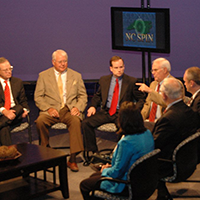- In a recent WFAE news interview, special master Bob Orr seemed to shift responsibility for North Carolina’s congressional maps from the court’s assigned special masters to the University of California professor advising them
- Orr also said that he and the other special masters responsible for redrawing the maps didn’t fully understand the criteria handed down to them by the state Supreme Court
- Orr admitted that the state legislature’s redrawn congressional map was the best map for competitive elections throughout North Carolina
The more information that comes to light regarding North Carolina’s 2022 redistricting litigation, the more questionable the court’s actions appear. Earlier this month, former State Supreme Court Justice Bob Orr sat down with WFAE’s “Inside Politics” to give a behind-the-scenes look at the court’s decision-making process in the most recent bout of redistricting.
Recall the Supreme court appointed “special masters” to oversee the General Assembly’s redraw of legislative and congressional maps. They were former Supreme Court Justices Bob Orr and Robert Edmunds and former Superior Court Judge Thomas Ross.
While the special masters found the redrawn legislative maps to be constitutional, they opted to throw out the redrawn map of congressional districts, opting instead to create their own congressional map for the 2022 election.
In the interview, Orr failed to address the concerns about him acting as a special master while also engaging in electioneering. The special masters drew new congressional districts as ordered by the state Supreme Court, and following that, Orr backed Democratic congressional candidates in districts he helped draw on behalf of the court. Orr did address concern about his involvement in splitting Charlotte, however. When asked if he considered Jeff Jackson during the decision to divide Charlotte, he denied the ability to make such a choice:
“Are you asking me if I drew it for Jeff Jackson?” Orr said. “You know, Jeff Jackson never entered my mind. You had three special masters — one a registered Republican, one a former Republican and one registered Democrat. We didn’t draw the maps in the sense of by ourselves. We had an expert who was hired to do the technical part of the map drawing.”
This is not the first time Orr has tried to shift the responsibility of the court-appointed special masters onto a single advisor. When legislative defendants sought the dismissal of two of the special masters’ assistants, Sam Wang and Tyler Jarvis, due to concerns over their ex parte communications with the plaintiff’s expert witnesses, Orr dismissed the notion that Wang had any influence over the maps, stating that because Wang did not physically draw the maps, he did not impact them.
Just as with the controversy with Wang and Jarvis, Orr attempted to remove himself from responsibility for the maps by implying they were solely created by a single advisor. The problem with that argument is that it not only denies the power the court gave to the special masters to establish new maps, but it also goes directly against what the court records say.
In invoices presented to the court (see below), special master Thomas Ross outlined the process for redrawing the congressional districts. He and the other special masters chose one of three maps drafted by University of California, Irvine professor Bernard Grofman and requested modifications to the map directly.

Highlight from the invoice from special master Thomas Ross detailing the special masters’ decision on a final congressional map and instructing edits to the map.
Orr appears to be attempting to put all responsibility onto Grofman and his undergraduate assistant, Zachary Griggy, for the maps being made more favorable to Democrats than even the plaintiff’s expert witnesses said could be expected from a map drawn using politically neutral criteria. Grofman is best known for his redistricting work in Virginia, where he worked to redraw district lines in 2015 and 2019 and was the Democrats’ choice as one of the two special masters for the commonwealth’s 2021 maps.
The special masters didn’t understand what the Supreme Court was looking for
Orr’s interview with WFAE also brought to light that the special masters shared a similar struggle to many in trying to understand what the state Supreme Court wanted in their ruling:
Orr said repeatedly the special masters were simply following the then-Democratic majority state Supreme Court’s instructions, even though Orr said they struggled to understand what the instructions were.
“We probably re-read that opinion multiple times trying to understand what we thought the court said needed to be done,” he said.”
The Supreme Court’s order was full of contradictions and vagueness. The court failed to set a specific standard to evaluate the maps, giving the special masters ample leeway to reject or approve maps. This confusion led to different standards being used by the special masters than were utilized by the plaintiff’s expert witness and the Supreme Court in throwing out the legislature’s original maps.
When the special masters changed the rules on how they judged maps, they caused the legislature’s map to move from clearly within the guidelines to just outside of them.
The General Assembly utilized the plaintiff’s expert witness’s data in the legislative redraw process to please the court. But doing so amid the court’s lack of clarity eventually resulted in a more favorable congressional map being drawn for Democrats than what the plaintiff’s expert witnesses data had shown.
The special masters decided to use different criteria from what were used for the ensemble maps that the plaintiff’s key expert witnesses used in the trial. When the special masters changed the rules on how they judged maps, they caused the legislature’s map to move from clearly within the guidelines to just outside of them.
The state legislature’s redrawn congressional map was more competitive and better for voters
When the legislature drew their court-ordered remedial congressional map, they created four highly competitive seats, making North Carolina one of the most competitive states and a critical state for both parties to gain congressional majorities. On the other hand, only one of North Carolina’s fourteen congressional seats in the special masters’ map was considered competitive, with seven Republican seats and six Democrat seats all but guaranteed.
Orr admitted that the second remedial congressional map would have been better for voters than the one he and the other special masters created:
“As a voter, competitive races are the best,” Orr said. “The second (Republican) map was a more competitive map. So if that is your criteria, that is the best map.”
While Orr is correct that they had to follow the formulas the court required them to follow, research from the Locke Foundation found the NCGA’s remedial map to be in line with what the court had asked for.
Orr’s audacious claim that he, as a special master, did not have any ability to affect the maps has no grounds. As a special master, he was one of three votes to decide:
- Which maps were to be approved
- Which elections would be considered in judging if the maps met the standards laid out by the court
- What edits to make to the maps presented by their advisor, Bernard Grofman
Even if Orr’s statements that he and the other special masters had no power over the maps were true, his admission that he and the other special masters lacked a complete understanding of what the court wanted is deeply concerning. Without seeking further clarity on the matter from the court, the special masters created maps the plaintiff’s expert’s data would consider to be a Democratic gerrymander.
If Orr wants to claim that these maps were the product of one advisor and his undergraduate assistant, he should explain what the state paid him, the other special masters, and their assistants $165,813.39 for.







